The year 2003 was significant for science: the whole human genome was sequenced. Knowing our internal source code led to many new medical insights like understanding inherited disorders and developing better treatments for them.
This also changed the consumer landscape as companies like 23andme and Ancestry were born. They offered direct-to-consumer genetic testing, which created totally new industry.
I bought 23andme genetic testing in 2016 and have been following closely the genetic testing scene and different service providers ever since.
It’s time to answer a most fundamental question from a consumer perspective: What do you get out of genetic testing?
Table of Contents
1. What is genetic testing?
Genetic testing as a process from a customer point of view can be simplified with the following picture:
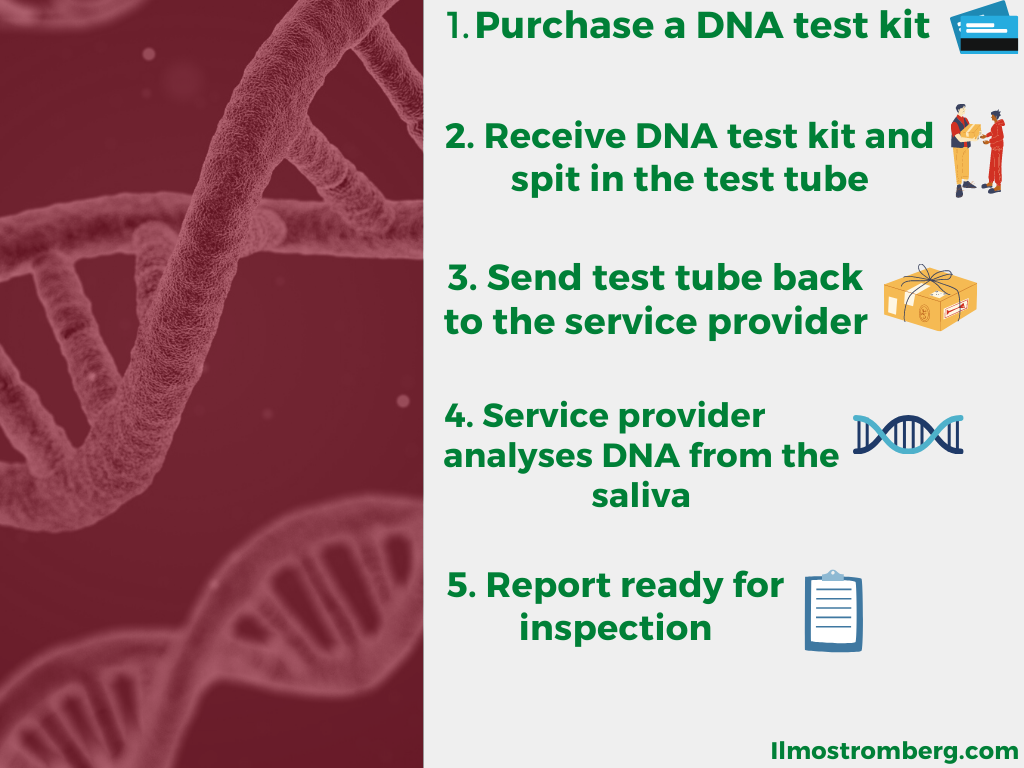
Depending on the service provider, this process usually takes from 6 weeks to 10 weeks.
The most interesting and complex part is number four, where DNA is extracted from a saliva sample in the laboratory. DNA is then digitized so that we can read it.
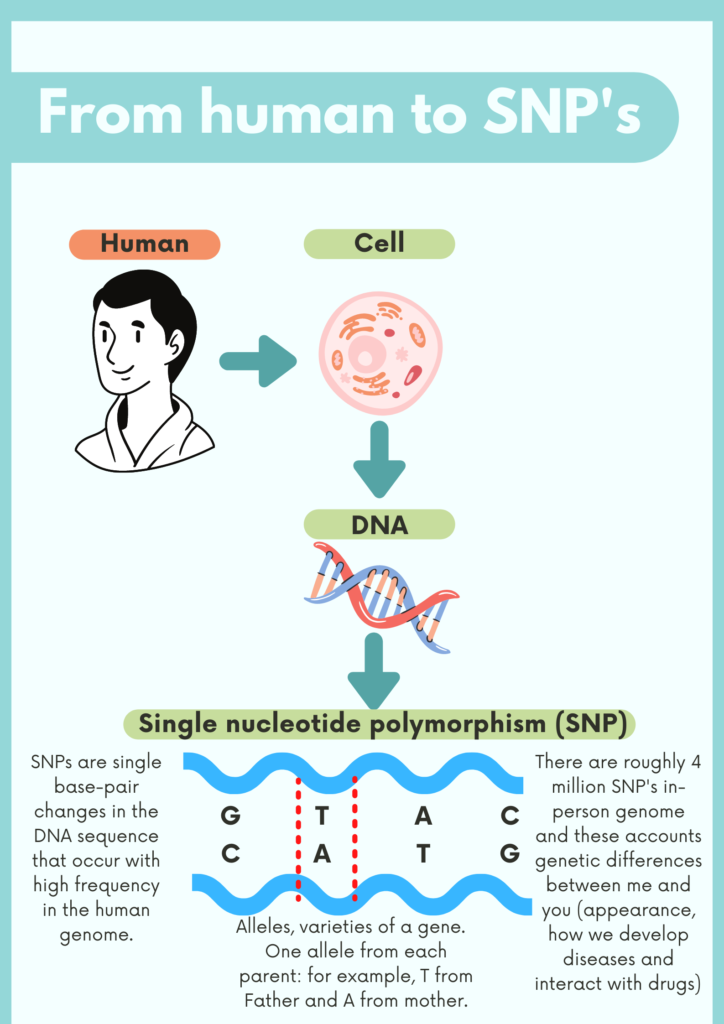
These genetic testing companies focus on SNP’s, known as genotyping analyses. In genotype analysis, specific locations in DNA are analyzed, and variations are identified. These variations are known to be associated with different health conditions and traits [1].
For practical examples, there are interesting studies on longevity and certain SNP’s [2]. Based on 23andme results, I have the following genotype on SNP rs2802292.
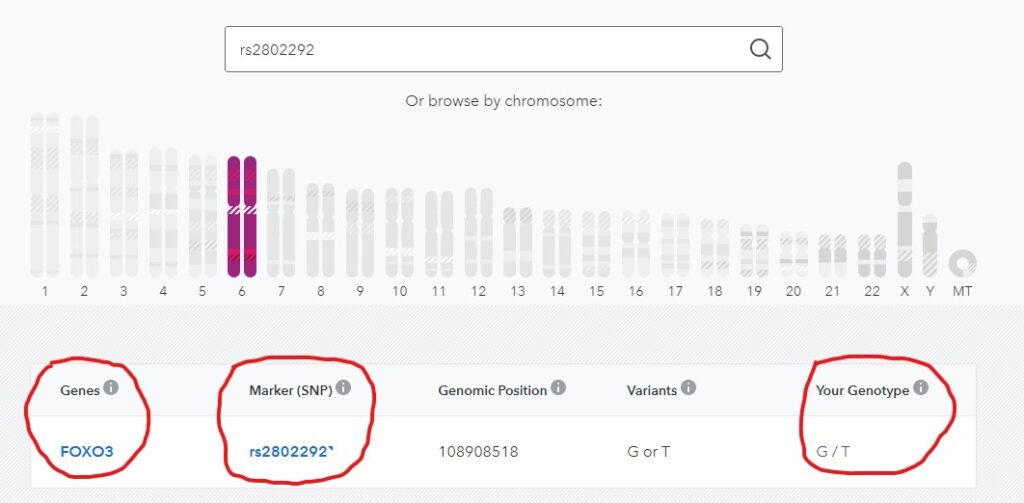
This picture itself does not give us much, but when we go to snpedia, we get more information on rs2802292. Snpedia is like a Wikipedia, but for an SNPs.

According to studies, I have one copy of a longevity gene (G), so I have a 1.5 and a 2-fold increased likelihood of living to be centenarians (reaching 100 years).
Before diving into reviews, let’s look the genetic testing as an industry.
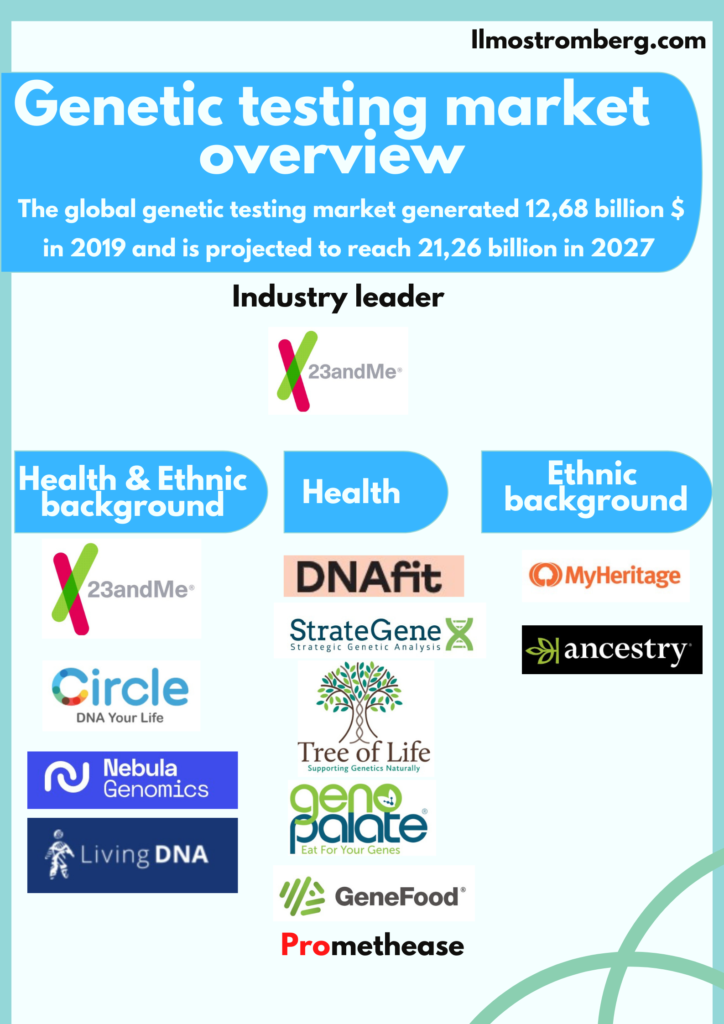
There are so many players in 2021, it’s hard to keep up as new companies pop up constantly.
In this blog post, I’m going to focus on 4 companies in the picture: 23andme, DNAfit, Stratagene, and promethease. I have bought reports from all the mentioned companies in the past 5 years. Now I will systematically analyze these reports, review them and highlight key findings.
2. 23andme Review
23andme can be seen as a synonym for genetic testing; it was the first company offering consumer DNA testing in 2007. In 2021 23andme is a market leader with a value of $3,5 billion, and now they are planning to go public in Q2 2021 [3].
23andme genetic testing results can be divided into two categories: 1. Ancestry 2. Health & traits. I will only focus here on health & traits even though ancestry is also interesting.
Let’s start with traits – genetics behind our appearance and senses. Traits are divided into 3 subcategories: physical features, taste & smell, and weird & wonderful.
Physical features
There are 21 features in the physical report, and they all are illustrated with a percentage chance of having that feature.
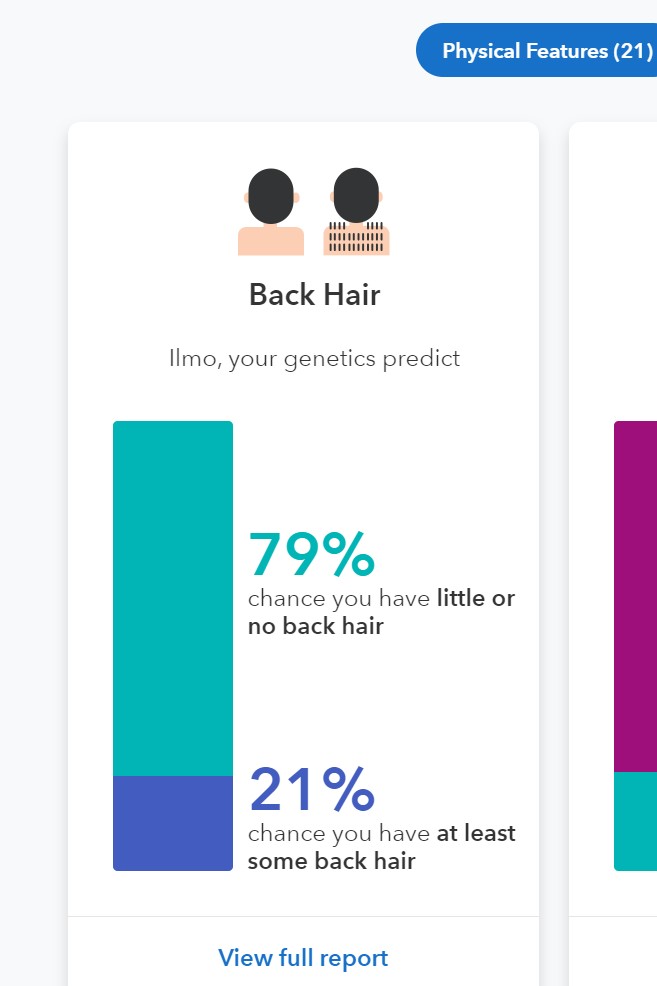
If these percentages are accurate, we should see that the 23andme physical feature report gets it more right than wrong. Its time to insert the first hypothesis:
If its not accurate, can we really trust health report either?
In the picture below I will look at the biggest percentage on trait and then state is it correct or wrong for me:
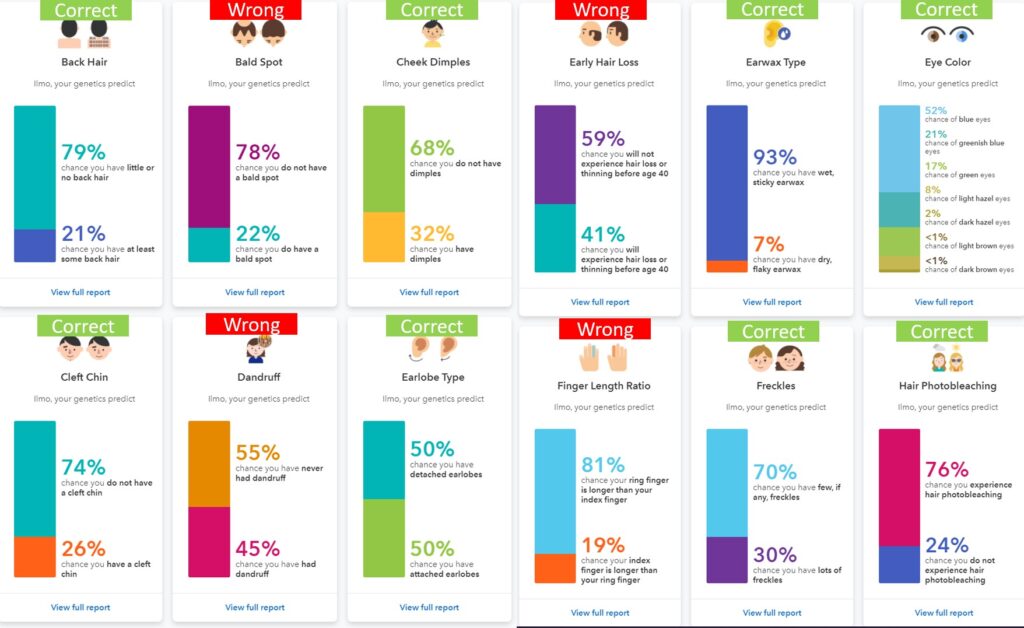
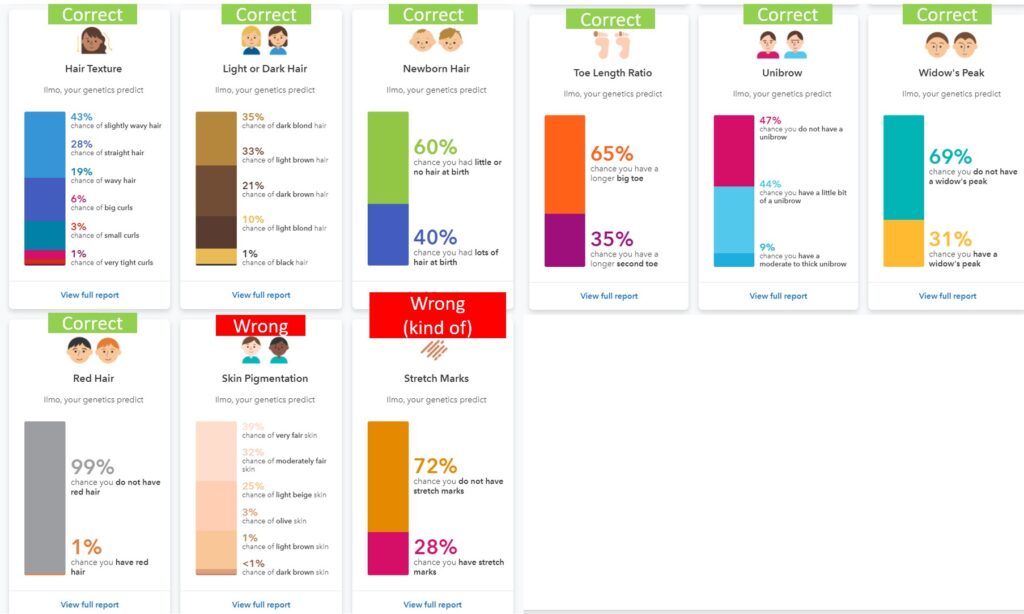
In some traits, I had to think for a moment, for example, stretch marks: I have small stretch marks in my arms as I was skinny from kid to young adult, but then I started to train. A rapid increase in muscle mass caused the stretch marks. My current lifestyle brought this trait alive.
In my case, this seems to be fairly accurate so we should be able to trust other reports too. Before moving to the health report, here are my result in the weird & wonderful category:
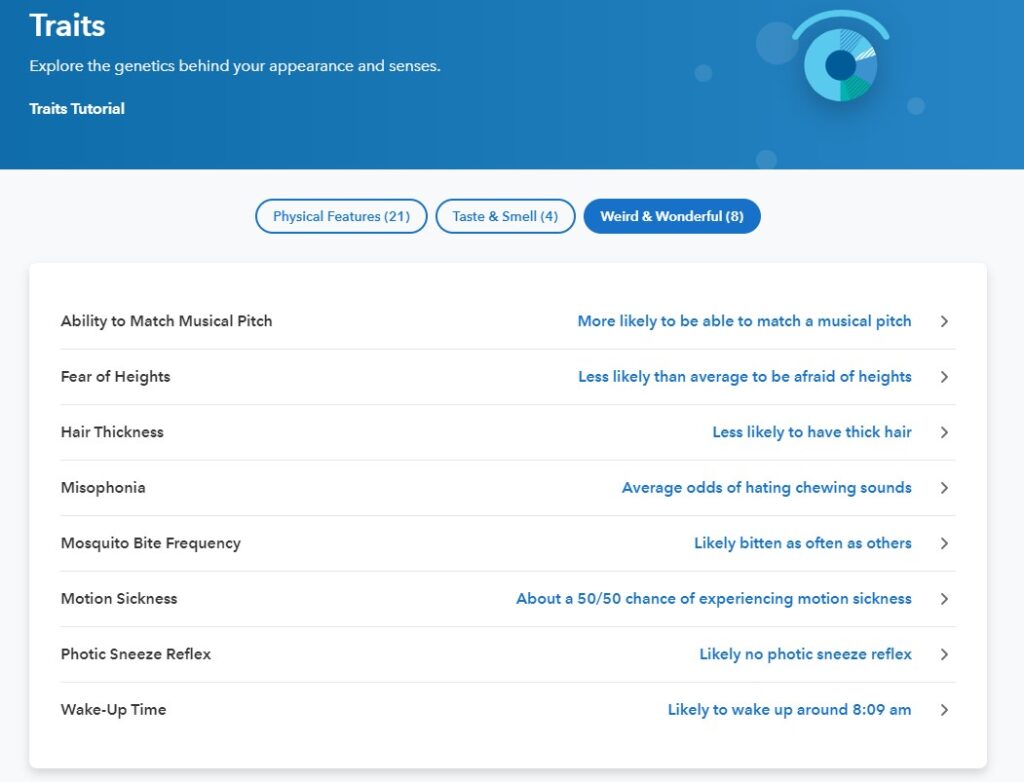
The first two traits had me laughing; I wish both were true…
Health reports
Health reports are divided into 3 categories:

My health predisposition report shows following results

I highlighted two points that need attention. First, it seems that I have an increased risk for age-related macular degeneration. What is that, and what can I do about it?
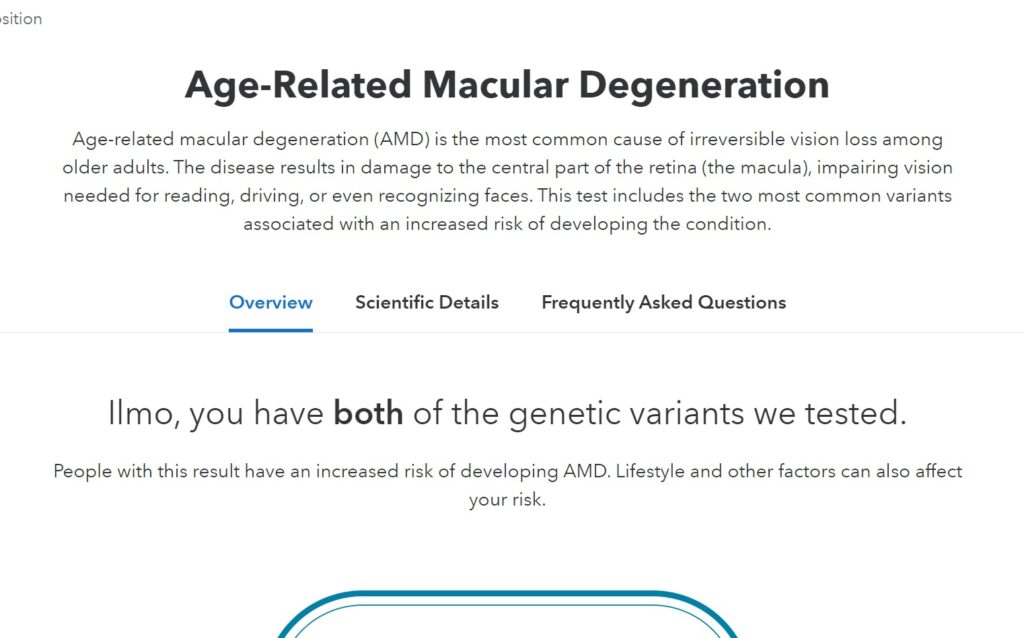
23andme has dedicated pages for each condition, so users can search for more information. Age-related macular degeneration is not life-threatening, but definitely something that I don’t want.
So, the next question is: what can I do about it?

23andme makes good visualization of lifestyle factors affecting the disease. This is the first real key information from genetic testing for me:
What about the actual risk probability? 23andme could do a better job visualizing this information
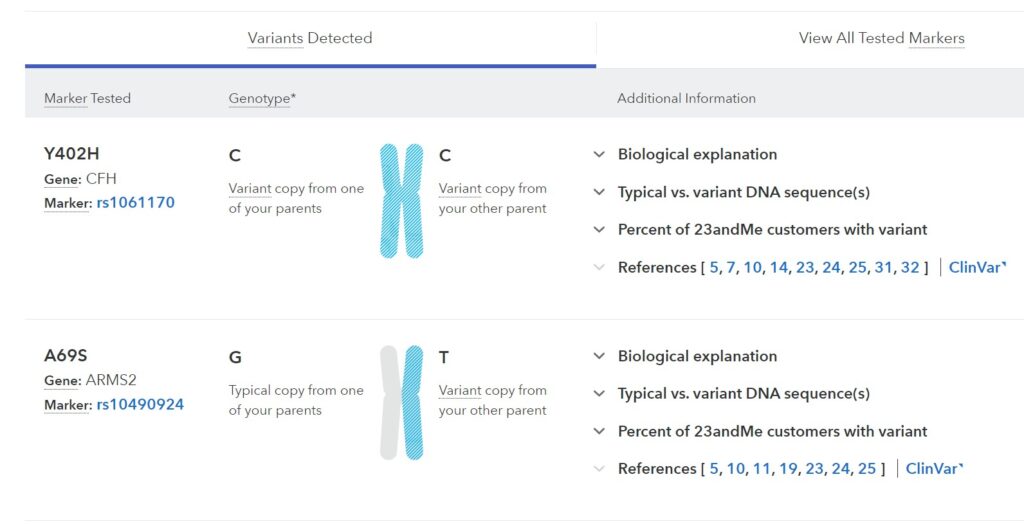
These are the variants I have that are connected to AMD. Then I have to scroll down to look at the following information to pinpoint the correct combo for me.
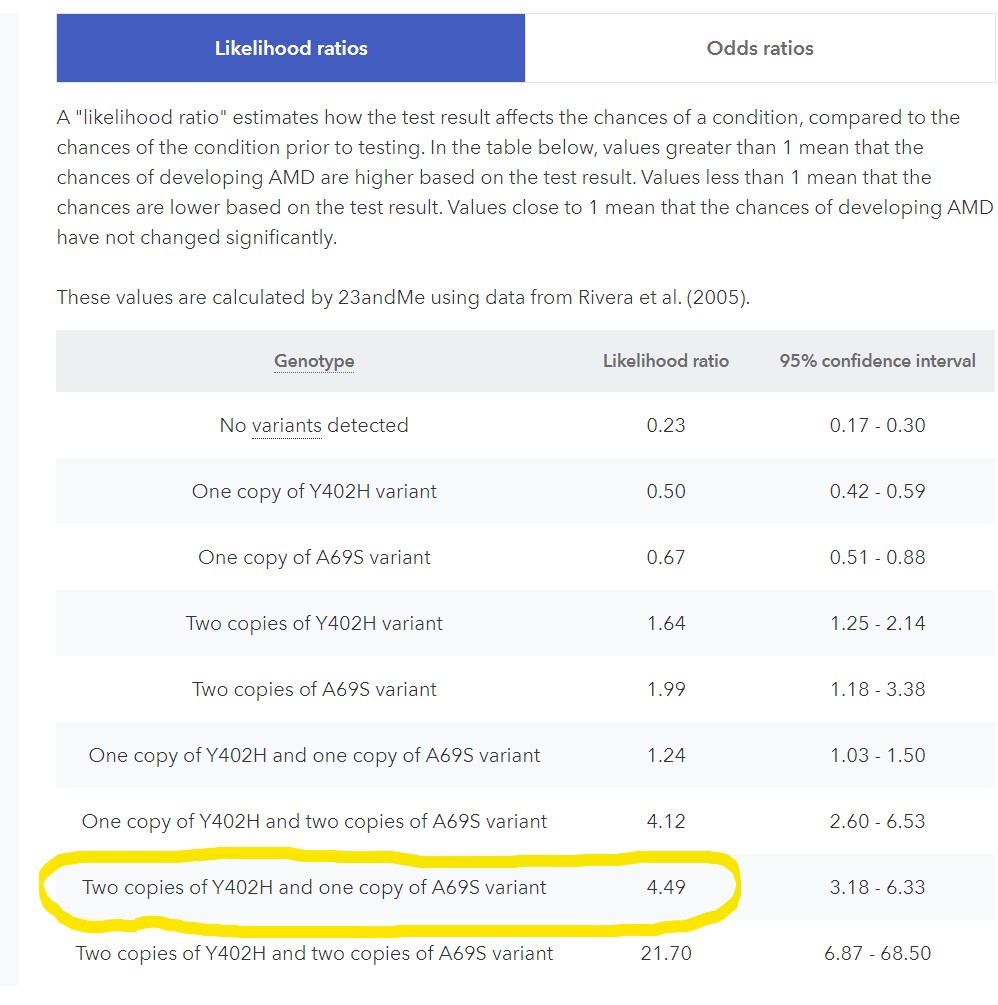
For some reason, I thought first that I had a likelihood ratio of 21,7 to develop AMD. Actually, it was the second-worst (4,49), but luckily there is a big difference between those ratios. 23andme could automatically point correct likelihood ratio for the user to make it more user-friendly.
My father and mother have also done 23andme, and they both had increased risk for AMD. It was no surprise that I also had it. My father’s likelihood ratio was 1,24, and my mother’s 4,49. When I brought this subject up with my parents, my mother revealed that she had been diagnosed with AMD this winter, but luckily there aren’t any symptoms yet.
The last point was related to Alzheimer’s disease and how the variant is not determined.

23andme gives the following short explanation: “This can be caused by random test error or other factors that interfere with the test.” So, we have to leave that as a mystery.
Carrier status
Carrier status holds specific rare genetic variants that could affect carriers’ child health; there are over 40 variants. I haven’t heard most of them, but I recognize a few, like sickle cell anemia or cystic fibrosis. I didn’t have any of these genetic variants (which is good).
Wellness
The last interesting part is wellness. Similar to traits; I wrote down what is correct for me and whats not:

I’m going to explain more the areas with dark blue box:
According to 23andme, deep sleepers tend to feel sleeper than others after a night of missed sleep. I have definitely have noticed this, a good night of sleep is important for me.
My genetic weight should be average (around 183 lbs / 83kg), however, I’m only 156 lbs / 71 kg.
Regarding muscle composition:
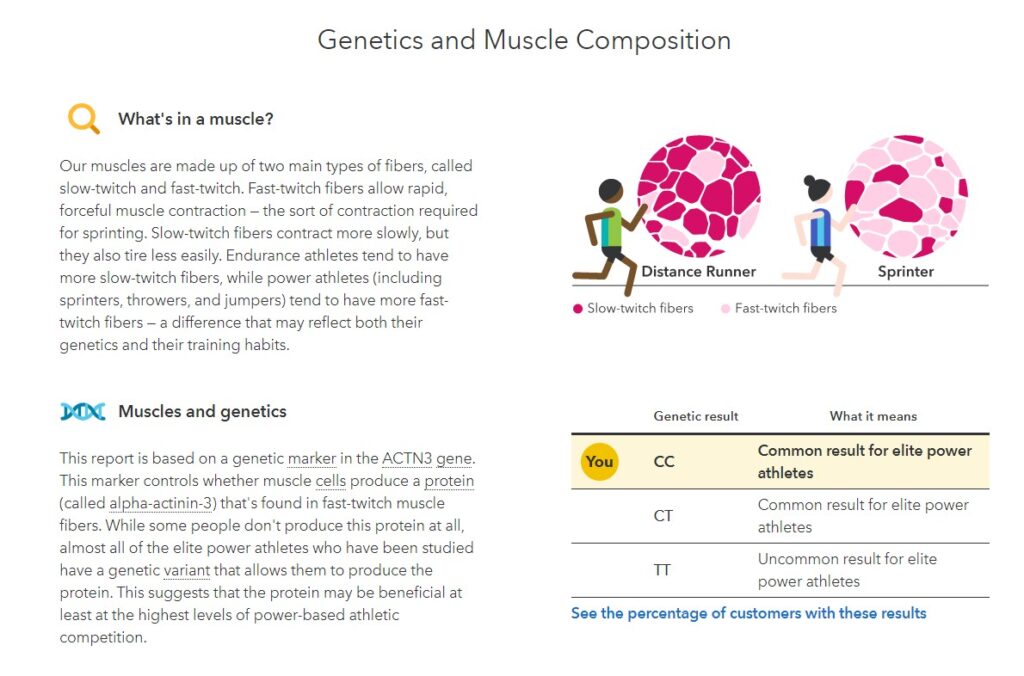
I agree with this even though I was skinny when I was young. I feel like I do better with explosive movements. I never really ran sprints, but I like explosive movements in boxing and calisthenics.
Saturated fat and weight are interesting; according to 23andme, my weight should be similar on diets high or low in saturated fat with the same number of total calories. I totally agree with this as my weight has been around 155 lbs over 10 years, but there has been a difference in saturated fat intake.
The last topic was sleep movement. Based on my genetics, I’m likely to move more than average in sleep. This is certainly true when I look at my Oura or Somnofy. Sometimes I have wondered about that, is there a problem as I tend to move a lot in the sleep, but it’s good to know that there’s a genetic reason for that.
Final thoughts about 23andme
The health report package costs 199 dollars (it also includes ancestry). 23andme is a good option to check for serious variants, but the wellness part is short. Some parts of the reports could be more user-friendly.
The key revelation for me was AMD. There were also some good points on the wellness reports that I have already experienced in my life.
3. Strategene Review
Strategene was launched in 2015 by Ben Lynch. Ben Lynch is also the author of the book Dirty Genes: A breakthrough program to treat the root cause of illness and optimize your health.
I bought the Strategene report in 2017. Strategene uses raw 23andme data to highlight genetic abnormalities or so-called dirty genes, a word that Ben likes to use. Strategene is also connected to seekinghealth online supplement shops. Now they also have their own DNA test.
Before diving into the report, I would like to raise possible concerns regarding Strategene and Ben Lynch.
Validity of Strategene and Ben Lynch
There’s a common unethical theme in the wellness industry: a company creates a made-up problem that affects consumers, and the only way to solve the problem is to buy the company’s product.
I’m not saying this is a case of Strategene and seeking health, but it’s important to understand this theme in the wellness industry and be skeptical.
There are few articles in well-respected sites that discuss the problems with Ben Lynch and Strategene (Forbes article & Mcgill article). Everybody can make their own conclusions after reading the articles.
Lastly, Ben Lynch is known as Dr. Ben Lynch, but he is a naturopathic doctor. His naturopathic background does not come up on his about me page.
Do I believe in Strategene? We need to go through the report so I can answer that question.
Strategene report
Strategene report is 20 pages in PDF, based on raw 23andmedata. Strategene report focuses on certain important genes like MTHFR, COMT, and MAOA (Don’t worry, I’ll explain this later on). The first part of the report is the overview:
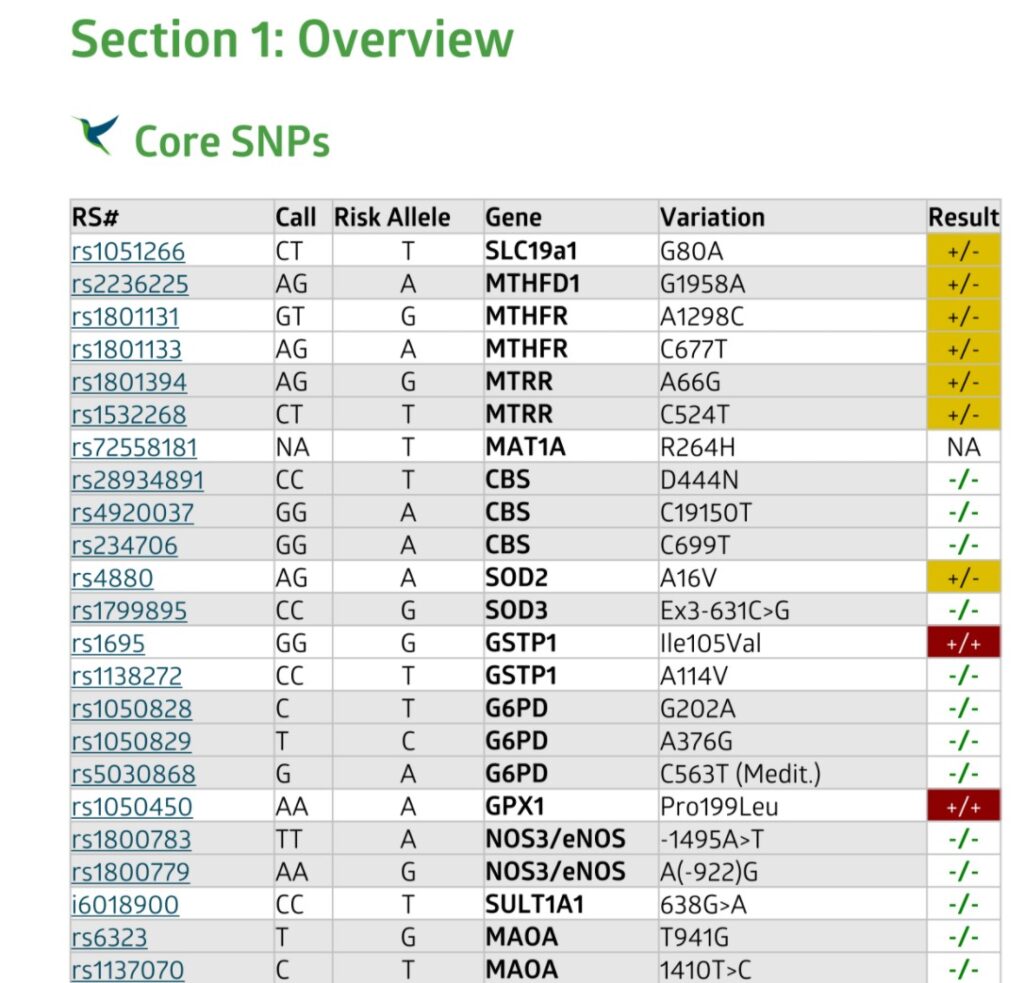
This overview does not tell us much, but in short: white background -/- means there is no risk allele, yellow means there is one risk allele, and red both risk alleles, are present. After the overview, each Gene result is explained one by one, starting from the top. There’s also background information on what functions does the genes affect. However, these are highly technical and hardly bring any value to the average reader.
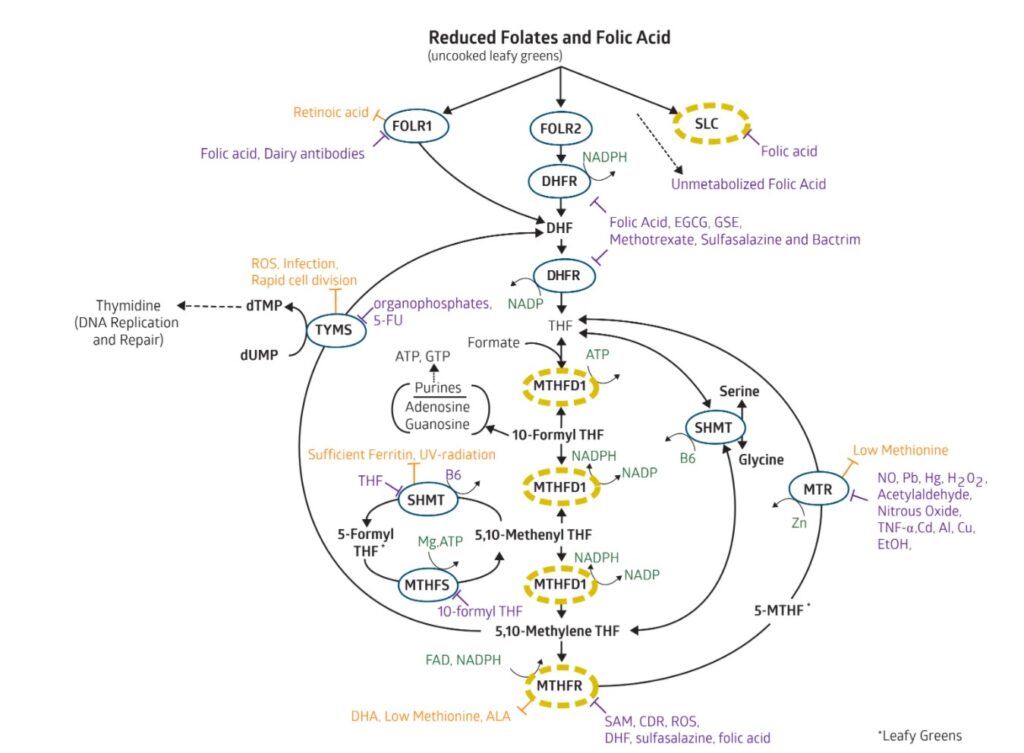
For one gene report structure is following:
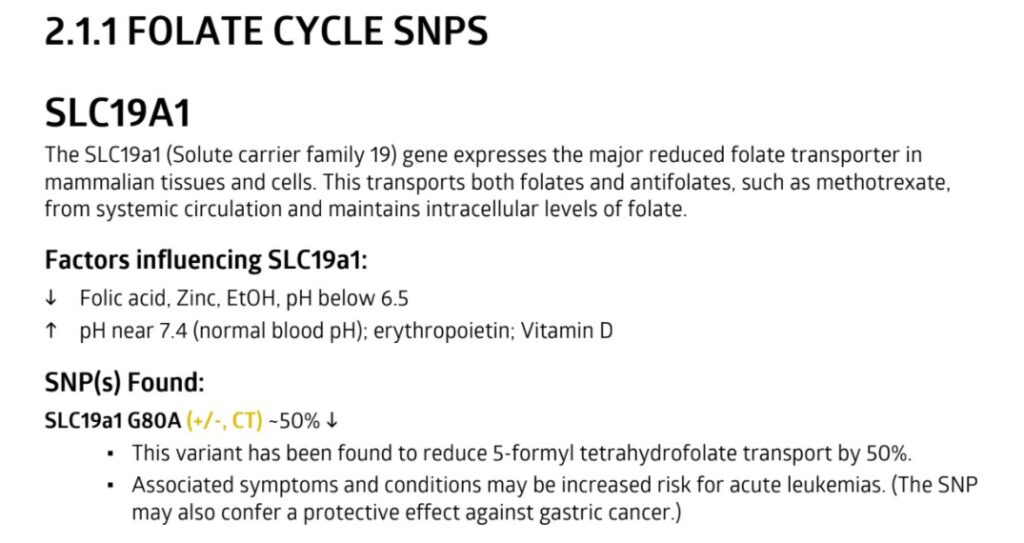
Similar to previous pictures, this does not give us much. There’s a short explanation of genes, factors influencing the gene, and my gene variant. According to Strategene, I have a gene variant that causes a 50% reduction in 5-formyl tetrahydrofolate transport. If I understand this correctly, I should supplement with Vitamin D to increase the activity and avoid Zinc.
23andme did a great job on their website to add references on different health claims. Strategene report itself does not have any reference information, but they have a dedicated website for sources. Sources are put under genes, but you have to search the correct study for a particular claim yourself.

I have to admit that these studies are too technical for me. With the SLC19A1 gene, it’s hard to make any conclusions or lifestyle changes as the report is not clear enough.
Let’s move on to the genes that are most talked about: MTHR and COMT.
MTHFR
Gene names are often confusing and easily forgettable, but you might have heard about MTHFR. There are websites, blog posts, and supplements dedicated just to MTHFR.
MTHFR gene controls enzyme methylenetetrahydrofolate reductase that plays a vital role in processing amino acid homocysteine to methionine [4]. This is very complicated molecular biology. It feels like I’m just putting random words in a row. Let’s look Strategene result on MTHFR and then keep opening this subject:

Based on the report, I have two variants that cause a 50% reduction in MTHFR activity. Fish oil supplements (as they have DHA & ALA) should increase the MTHFR activity, but I don’t have enough information here to make concrete decisions. I need to search it elsewhere with the following questions:
If I do, what does it mean?
And what can I do about it?
I found out that respected researcher Dr. Rhonda Patrick had made good video about MTHFR. Rhonda’s video also states that there are reduced MTHFR activity based on the SNPs I have. There’s an indication for elevated homocysteine levels with reduced MTHFR activity.
I actually measured my homocysteine levels out of curiosity in 2020 august. The result showed that I didn’t have elevated homocysteine levels

Folate (B9) could also be lower with reduced MTHFR activity, but that wasn’t the case either when I measured my Vitamin B9 levels in 2018. I rest the case with MTHFR as it seems that it’s not a problem with me.
COMT
COMT Gene is the most interesting one from the Strategene report. It’s connected to neurotransmitters like dopamine and epinephrine. My results in COMT caught my attention as both were red (negative):

Both variants decrease my COMT activity: I have the same question here as in the MTHFR section.
If I do, what does it mean?
And what can I do about it?
With MTHFR, there were blood tests to check possible problems. However, with COMT, we have to dig deeper.
COMT is also known as the warrior/worrier gene [5]. It would be cool to be a warrior, however with variants AA in rs4680; I’m a worrier. AA’s are associated with being less extroverted [6] and increased risk of mental health issues like anxiety and OCD [7]. I’m definitely more introverted than extroverted, and I know few things about anxiety. I’m not at my best when I’m under heavy stress, which is typical for AAs [8].
Obviously, these all are association studies, but I kind of recognize myself here. Now, is there a way to increase my COMT activity?
It seems that it’s easier to avoid things that can decrease COMT activity, like environmental toxins [13] and stress [14].
Surprisingly, it seems that soy can actually increase COMT activity [15].
There’s been some bad rep with soy, especially related to testosterone, but it seems that it’s only a problem if you take it too much [16].
I’m not going to be an everyday soy eater, but I won’t say no to it either. The most important thing is stress management and avoiding environmental toxins.
Final thoughts on Strategene report
I’m going to be blunt here. The only positive thing about the Strategene report was that I learned about the existence of MTHFR and COMT genes. Strategene explanation about the results was poor. I have to search for more information else were (and found interesting insights). Also, sources weren’t linked directly to claims which aren’t reader-friendly. Regarding the validity and conflict of interest: the actual report didn’t push readers to buy supplements from seekinghealth, which was positive.
4. DNAfit Review
DNAfit is an interesting addition to this review. DNAfit offers genetic reports and guides related to fitness and nutrition. They also offer one-to-one expert support on health transformation.
I bought the fitness and nutrition report 2018 that’s based on 23andmedata. Currently, their offering for 23andme users looks like this:
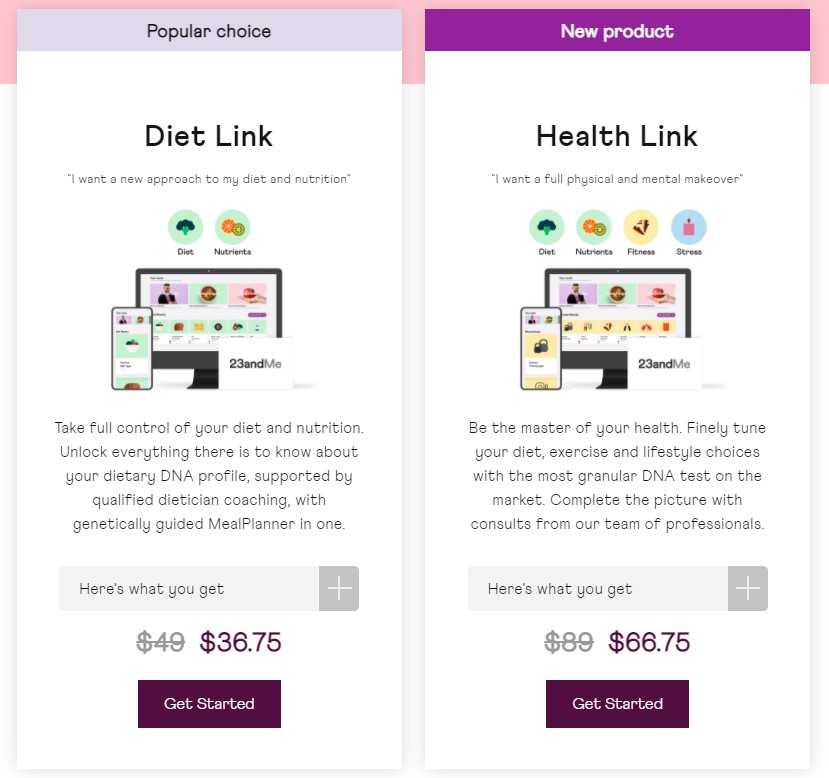
Diet Link is exact same report that I bought in 2018, health link has both diet and fitness reports, but also some extra topics like sleep and stress that were not available in 2018.
Let’s start with the diet report, its PDF file with 24 pages. The first thing to notice is the visually eye-pleasing look:

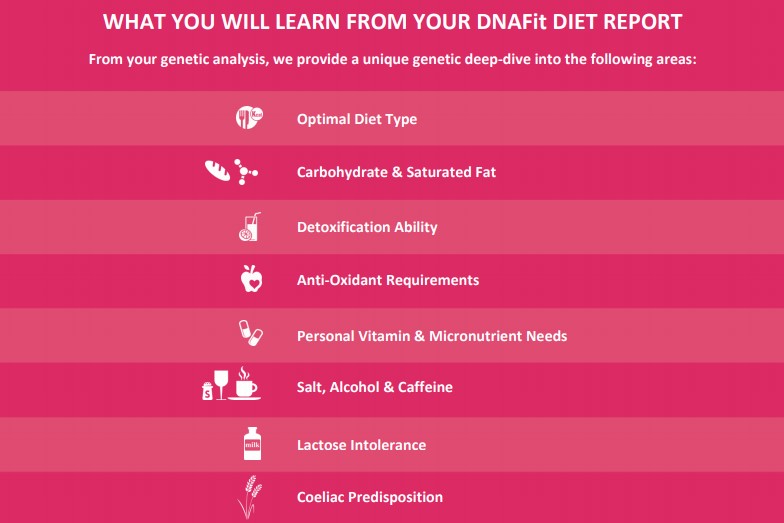
DNAFit covers 8 topics in the diet; a few of them are also present in 23andme: Caffeine, alcohol, lactose intolerance, and coeliac predisposition. In these cases, it’s relevant to look at both DNAFit and 23andme. Are they giving the same message, or is there a difference? I will also highlight the most interesting findings from the report overall.
Optimal diet type
Optimal diet type report starts with overall recommendation view:

Nutrient overview brings interesting revelations: I should increase vitamin B intake, antioxidants, omega 3, and fiber.
However, the decreased section has “no brainers”, there probably won’t be a report that would suggest an increased need for refined carbs or sugars.
Why do I need to increase my Vitamin B intake?
DNAfit report brings up again our old friend MTHFR gene:
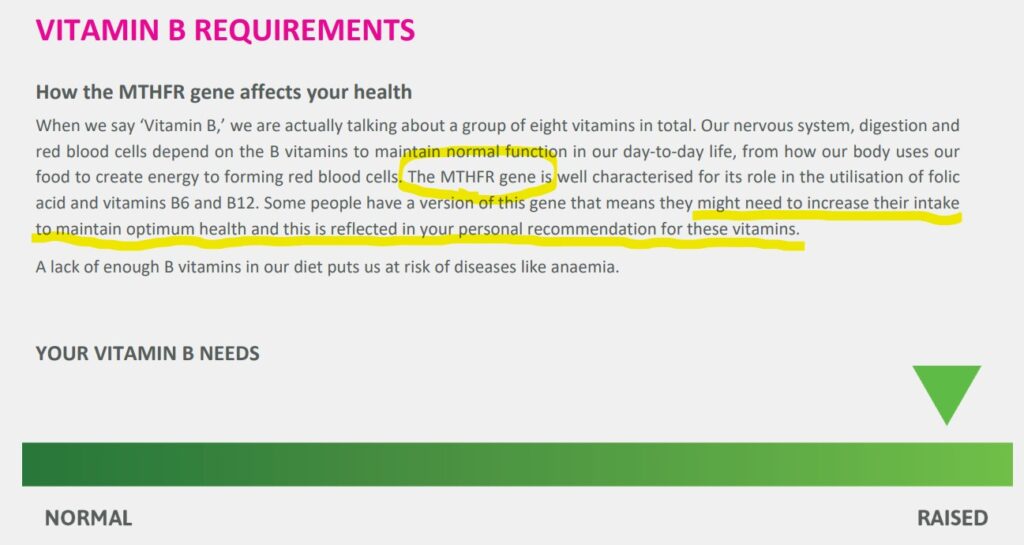
As already discussed in the Strategene review, my Vitamin B levels have been optimal in all blood tests. What I like about DNAFit is that they are not pushing Vitamin B supplementation, but rather giving tips for Vitamin B rich foods:
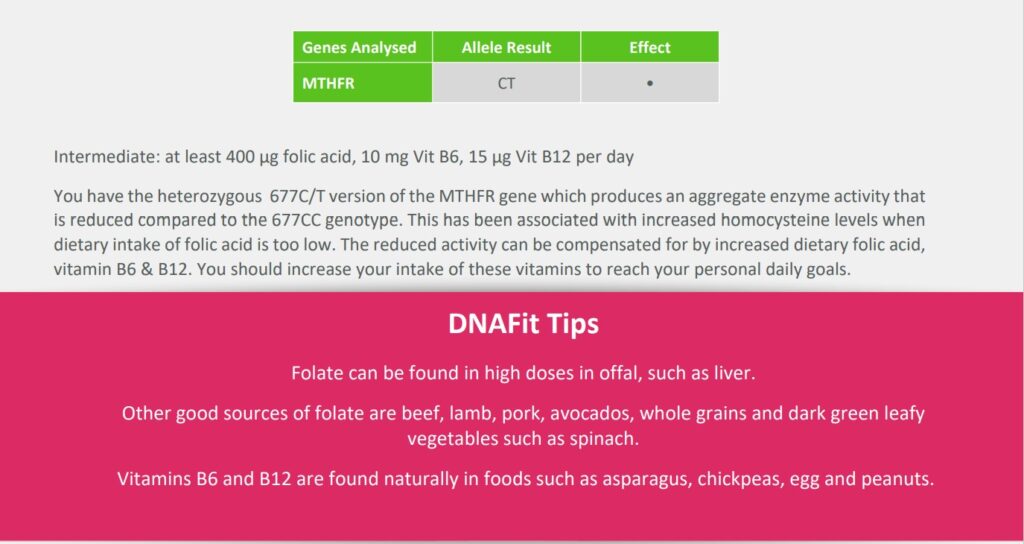
Effect with one black dot means medium association, and two dots would mean strong association.
My diet contains lots of avocados and dark green leafy vegetables. I probably get enough vitamin B from there. This isn’t a major insight as my levels are optimal, but it’s good to keep this in mind if I do drastic diet changes.
Why do I need to increase my antioxidant intake?
DNAFit explains well what antioxidant is and also brings up interesting study:
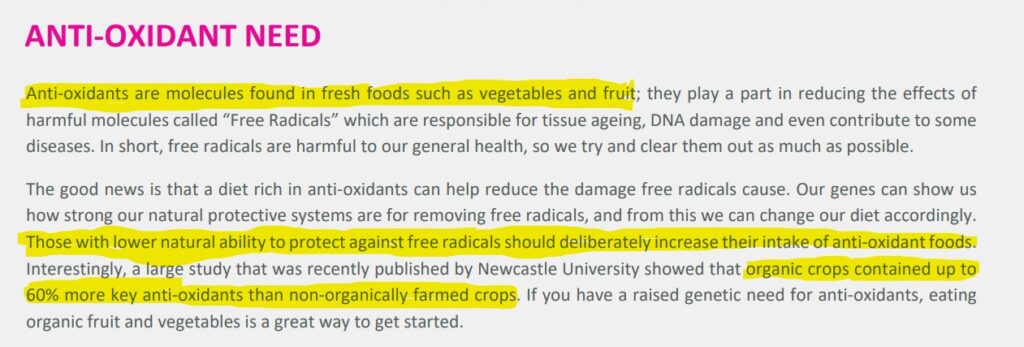
DNAFit didn’t add the source for this study so I had to do some googling, here is the study [17]. This seems to be a comprehensive meta-analysis although the conflict of interests mentions one of the authors having organic farm business.

My selenium levels were measured in 2018; the result was 2.1 umol/l (ref. range 1.1 – 2.8). DNAfit suggests 105 mcg/day when national guidelines in Finland are 60 mcg [18] and in the US 55 mcg [19].
That’s over a 40 % increase! Before increasing my selenium intake, I need to dig deeper into this. It seems that the GPX1 is the major component here as it has two dots (strong association).
DNAfit report could include the actual SNP information to report as GPX1 has many SNP’s connected to it. It seems that DNAfit is referring to this SNP:

Selenium is widely discussed in this study related to GPX1 [20]. It seems that Selenium definitely has good protective properties. It didn’t even matter if it’s coming from food or supplement.
As my blood levels were in the average range, I will give a light selenium boost. I don’t want to overdo it as there are negative consequences with too much selenium [21].
Supplementing Selenium is easy as it gets; I can basically eat one brazil nut and get around 70 mcg. That’s already over the suggested daily levels!
Why do I need to increase my Omega 3 intake?
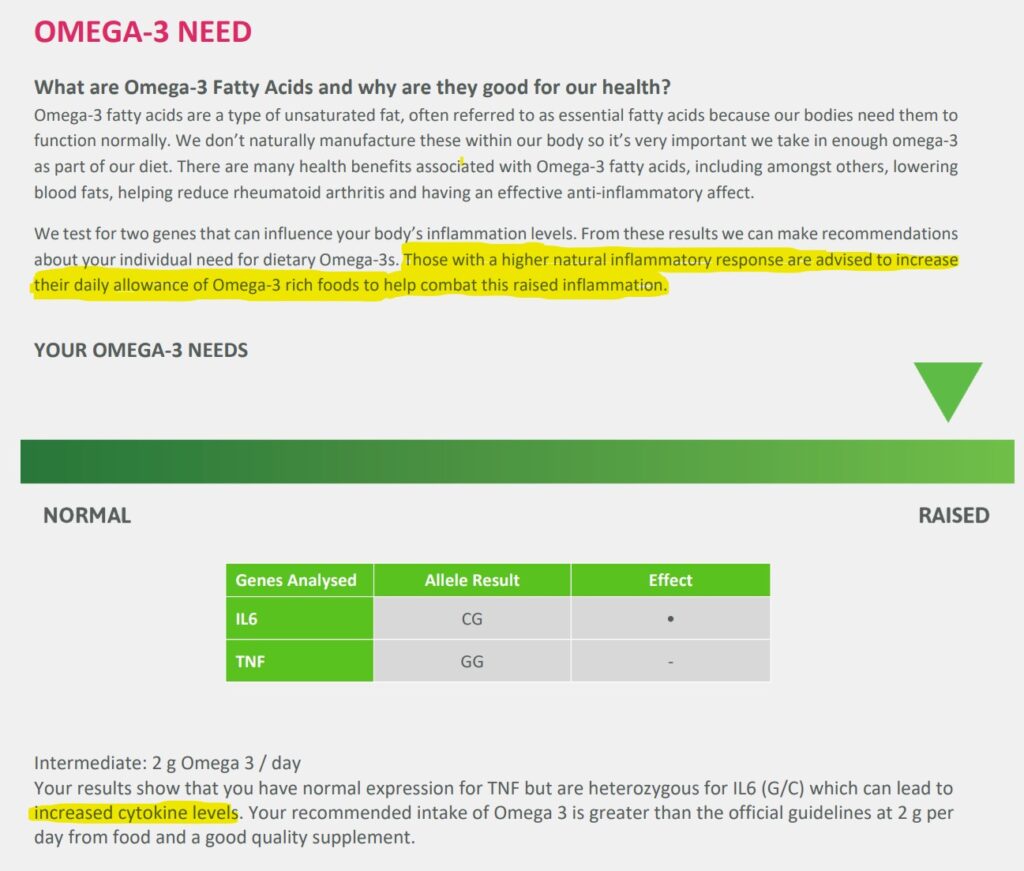
Krill oil/Fish oil supplements are generally safe, but the only thing to look out for is toxins like mercury. Luckily krill is bottom in the ocean food chain, so they don’t have time to accumulate high levels of toxins.
Why do I need to decrease my salt consumption?
If I had to choose between hamburgers and fries versus cakes and chocolates, I would choose the saltier one. Unfortunately for me, it seems that I should monitor my salt intake:
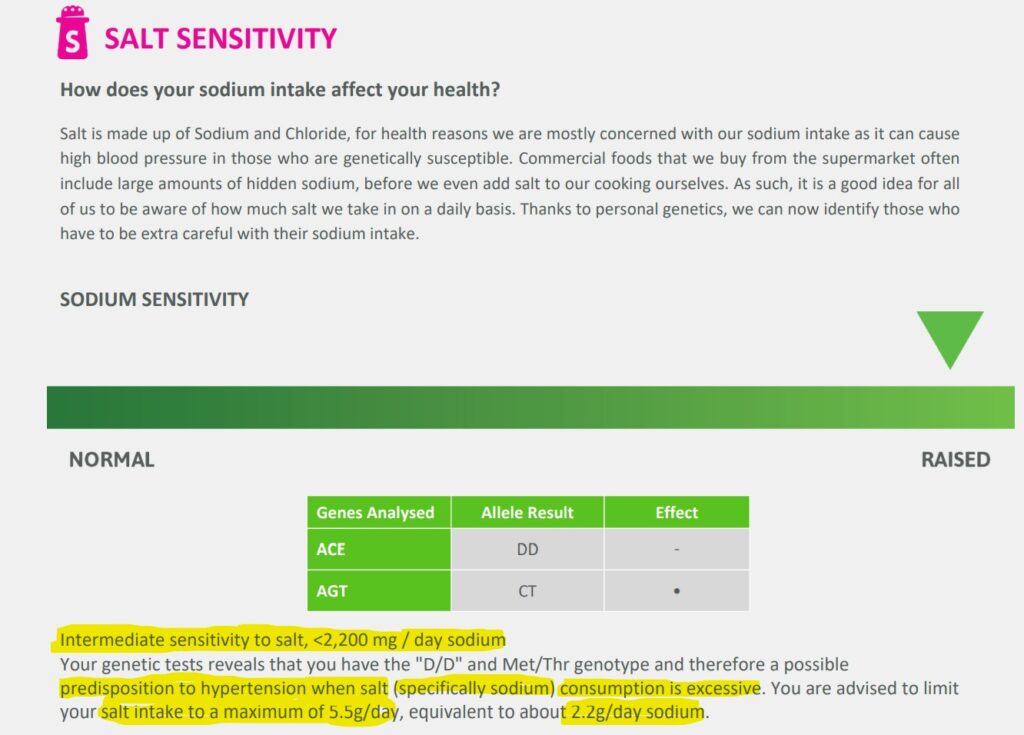
According to DNAFit, I should consume less than 2,2g of sodium or 5,5g of salt per day. I was surprised by these values as WHO has already stricter recommendations.
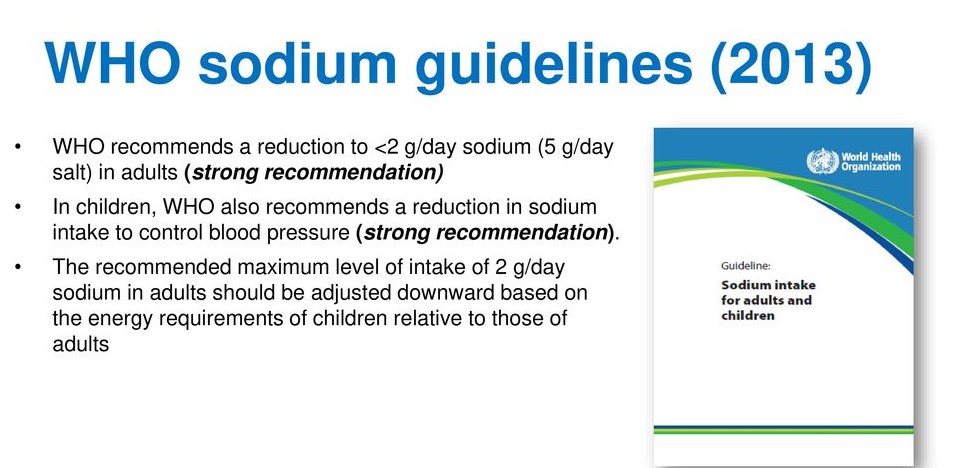
I think DNAFit drop ball here, If my sodium sensitivity is raised, recommendations for me should be below WHO’s equivalent.
Comparing 23andme and DnaFit results
In caffeine, DNAFit states that I should keep within recommended guidelines for caffeine consumption. I have two copies of the rapid version of the enzyme (which means that I’m a fast metabolizer of caffeine). 23andme brings the same point but also states that I’m more likely to consume caffeine more.
For Lactose intolerance, DNAFit states that I have lactase persistence and an ability to continue to digest lactose from dairy products. 23andme agrees but brings more comprehensive background information related to the topic.
For some reason, alcohol response couldn’t be assessed in DNAFit, but in 23andme conclusion was that I was unlikely to flush after drinking alcohol. Most likely DNAFit was looking at different SNP’s but they weren’t available in 23andme raw data.
This was the diet report, lets move on to the fitness report
DNAFit fitness report
The fitness report is 15 pages long and covers the following areas:
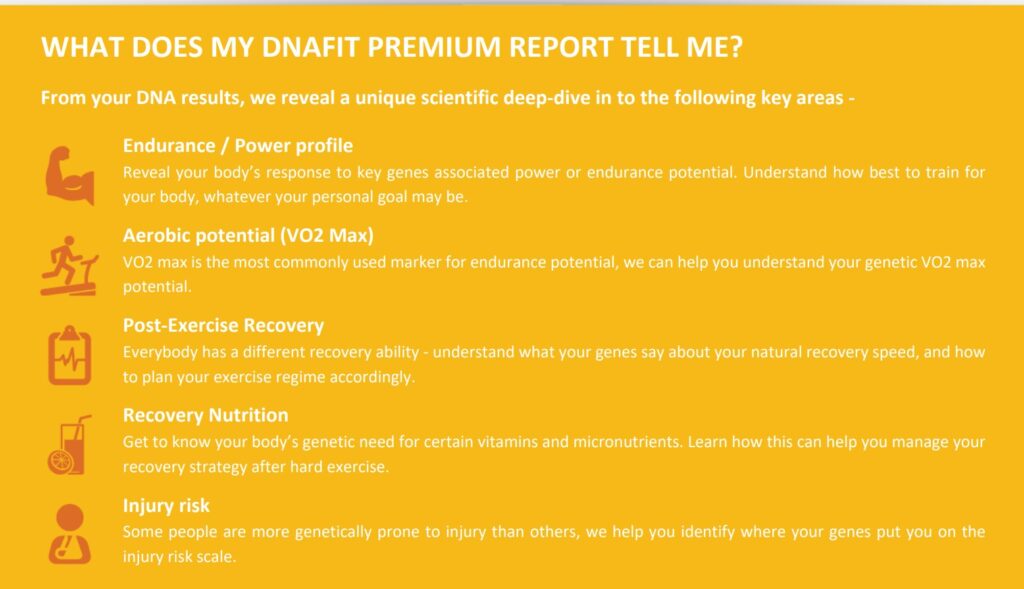
I will recap endurance/power profile and recovery nutrition.
Endurance / Power profile
Both 23andme and DNAFit highlights power domination in my genetic profile. I like how DNAFit presents this data:
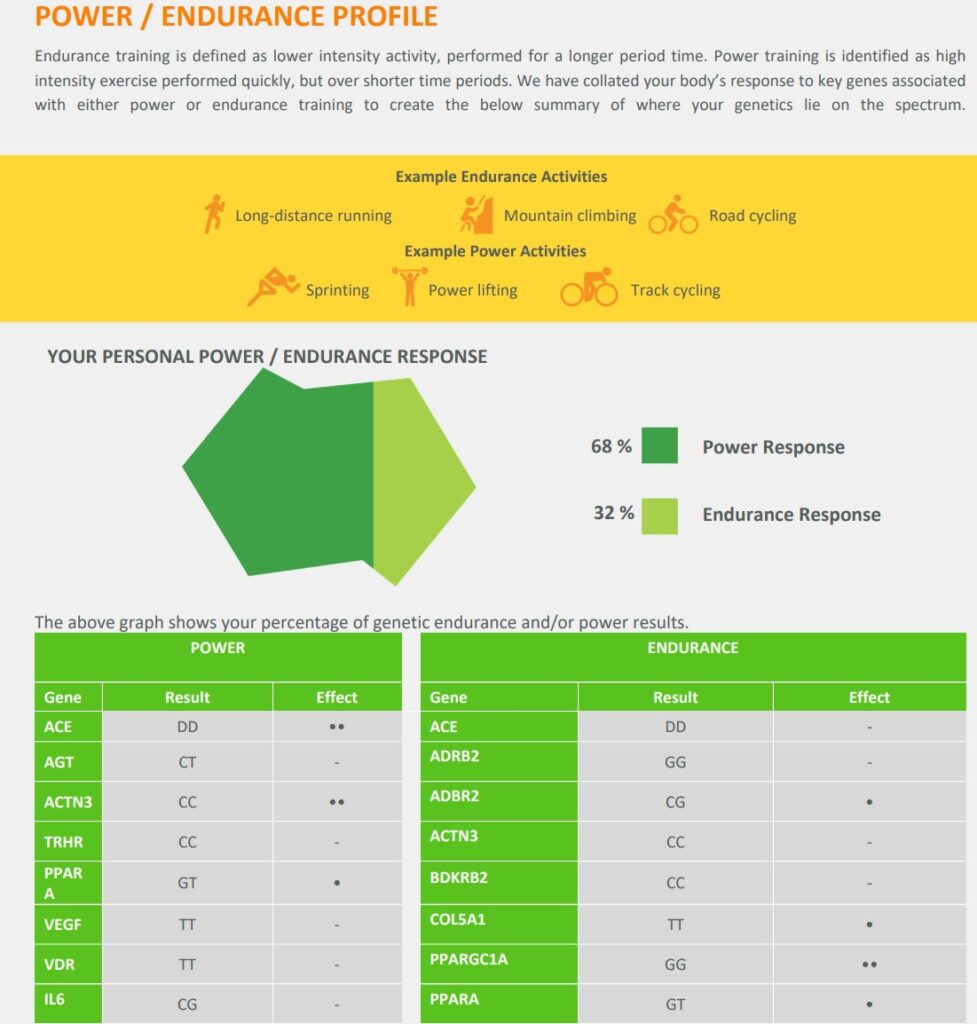
According to DNAFit, these results should be taken into consideration when planning a training regimen:

This might be the most interesting insight, as there are also scientific studies regarding training and genetics [24]. It seems that the correct type of training based on genetics leads to better performance in long run.
Recovery nutrition
DNAFit offers the following table for personalized recovery nutrition (I add information on the right side how much they differ from general recommendations)
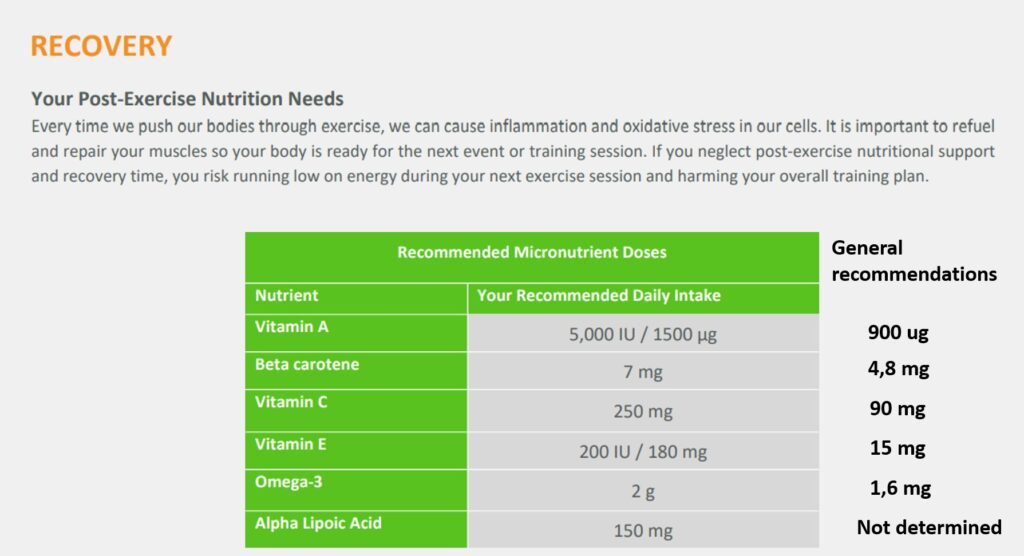
This is interesting but I’m not going to take it as a grain of salt. I need to research the pros and cons of supplementing with these micronutrients.
Final thoughts on DNAFit
I really liked DNAFit; it covers diet and fitness comprehensively, elements that are a big part of wellbeing. You get concrete insights which are the most important thing in genetic testing. Visually DNAFit report is excellent.
The negative thing is the lack of sources. You have to find them by yourself. If the report would include sources, then I could give it 5 stars. If you are already a 23andme customer and interested in diet and fitness, 66 dollars ain’t a bad price for a performance-optimizing report.
5. Promethease Review
If you are still here with me, this is the last one. Promethease differs greatly from others. Promethease is based on SNPedia, which I have cited here already. Promethease connects personal DNA reports to SNPedia information, making it a literature retrieval system.
If you like visually beautiful reports (like DNAFit), then promethease isn’t for you. Even with an ugly appearance, promethease offers the most information and with the lowest price. Basically, every genetic detail mentioned in 23andme, strategene, or DNAFIT should be found here. It also contains everything else that wasn’t mentioned. SNPedia contains over 100 000 gene variants.
Promethease works in a web browser. The basic view has a list of relevant SNP’s and a filter window on the right.
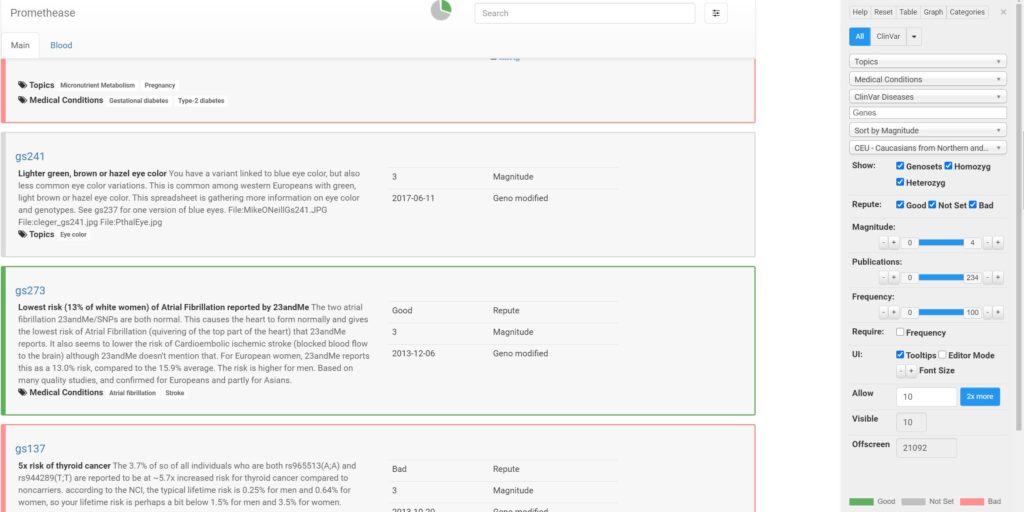
Then bottom right there is categorizing of gene and does it have a good, bad or unknown effect.
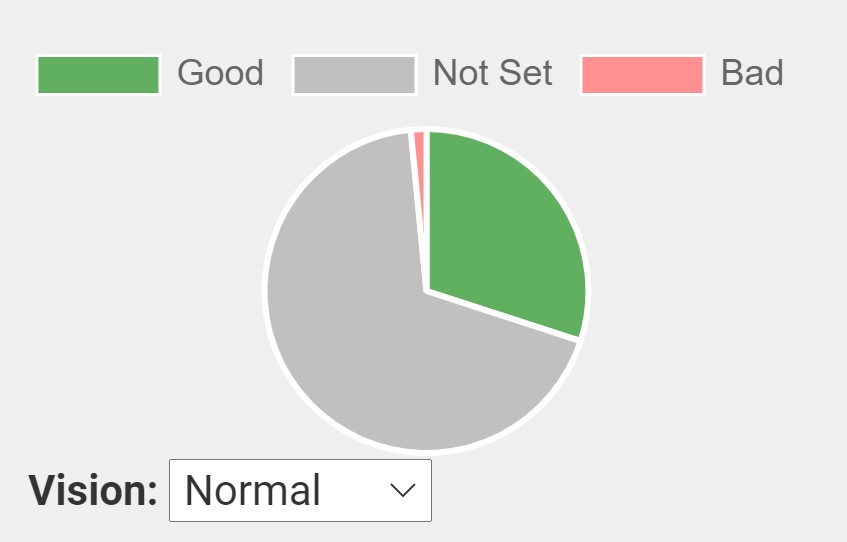
Good has 6330 SNP’s (30%), bad 327 (1,55%) and not set variations 14445 (68,45%). This illustrates how much there is still unknown SNP’s or SNP’s that don’t have any effect.
Next, I will highlight the most interesting good and bad SNP’s, based on magnitude number. Magnitude is a subjective measure of interest that can be anything between 0 to 10. It’s like an IMDB score for movies. Higher the score, the more relevance it has subjectively.
Good or bad news first? Let’s take the bad news.
Bad SNP’s
The highest magnitude (3.1) was for type 2 diabetes:

This is good to know and also not a surprise as type 2 has affected my close family. It’s important to keep an eye on fasting plasma glucose levels.
There were few cancers risks with magnitude 3:
5x risk of thyroid cancer (According to the NCI, the typical lifetime risk is 0,25% for men, so for me, it’s a bit below 1,5%)
One SNP gave 2,5x risk for prostate cancer and the other one 6,2x risk. This is relevant because it’s the most common cancer in men in Finland, although it’s mostly older men’s cancer (average age 70).
Good SNP’s
Magnitudes in SNP’s were lower than in bad ones.
I have reduced risk for late-onset asthma (0,84x), Alzheimer (0,87x), and risk for restless legs (0,70x).
Longevity and anti-aging are something that I’m interested in. I was happy to see this variant:

Final thoughts on Promethease
Promethease isn’t for everybody, but there’s more data in it than other reports can combine. If you are into genetic data digging, Promethease is best for that.
Even if you already have 23andme and DNAFit, Promethease offers more insights into your genetic profile at an exceptionally cheap price (12 dollars).
6. Conclusion
We are all individuals with unique genetic makeup. The time for generalized recommendations for diet, vitamin intake, or exercise is over, in my opinion. We should move towards personalized health plans which are done by genetic testing and experiments.
We still need more scientific studies to understand different SNP’s, but even with current knowledge, we can already get valuable insights, as I have shown in this review. Here is a recap of all the important insights I learned through genetic testing:
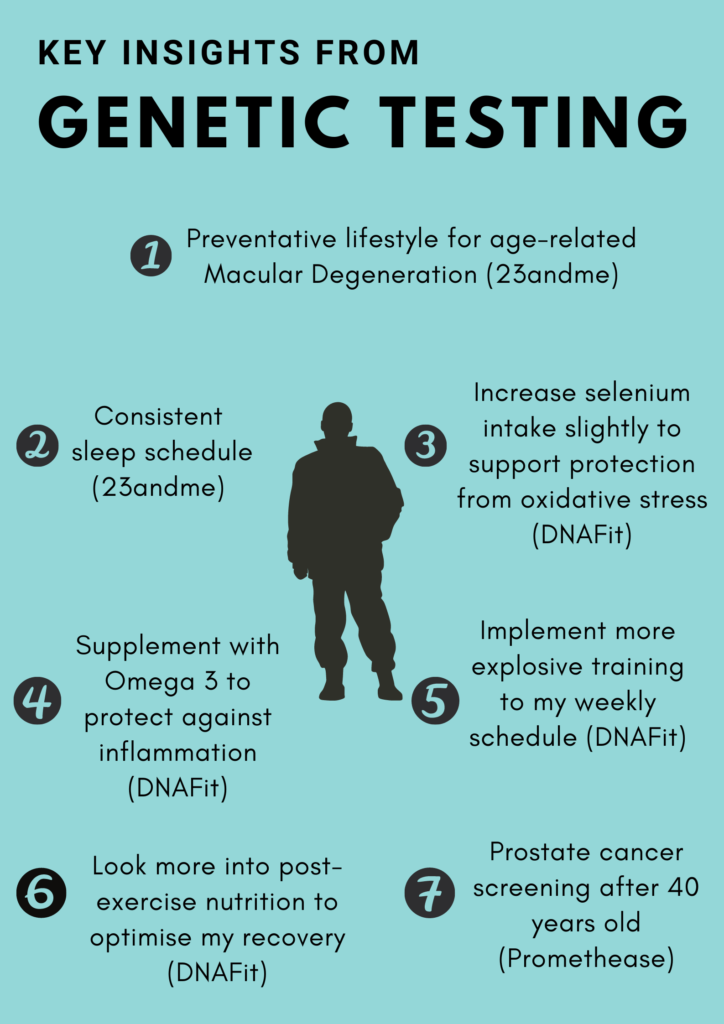


This Post Has 3 Comments
Due to epigenetics this DNA test have only sense for confirming diagnosis for some gene related illnesses
It’s very unclear what the colors of the chapter stars mean. Very confusing.
Ok, now I get it. The stars are referring to the info above them.